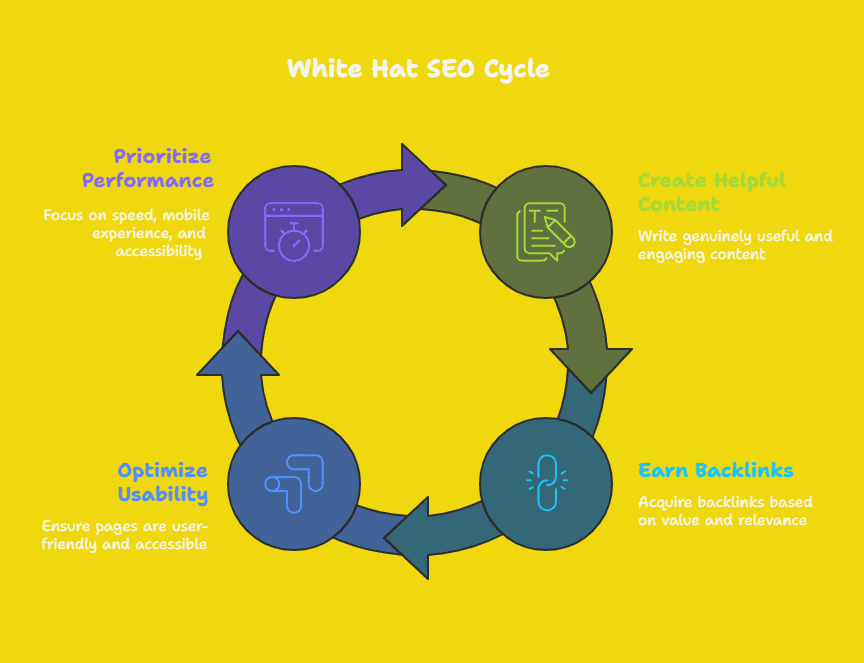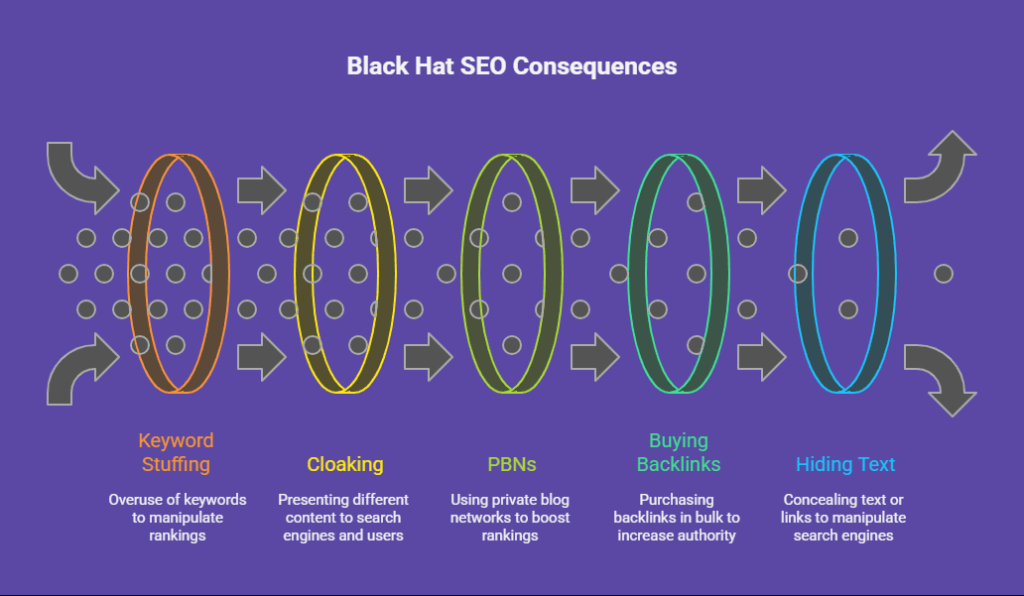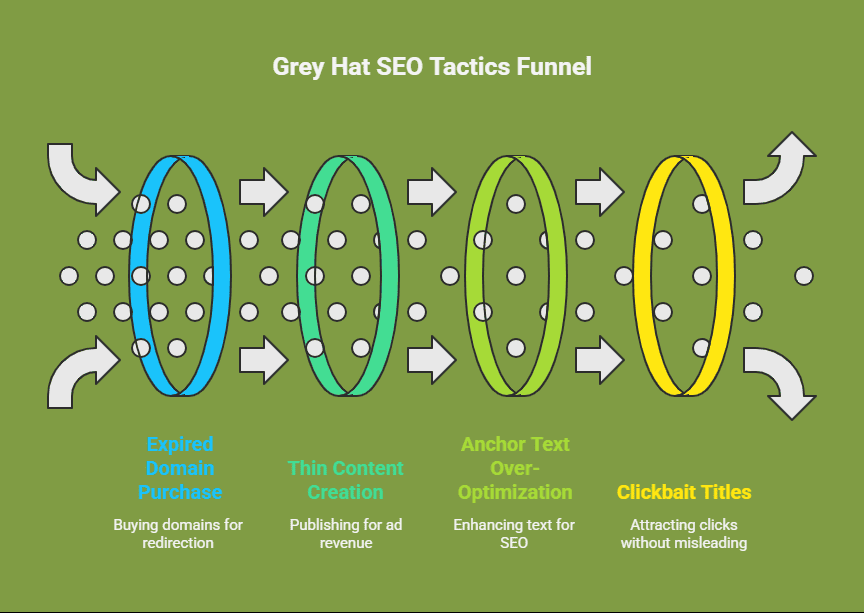
16 Jul 2025
SEO Hats Decoded: White Hat, Black Hat, and Gray Hat SEO Explained
Table Of Content
Table of Contents
Have you ever seen a website suddenly rise to the top of Google search rankings, only to sink just as quickly? That’s not wizardry. That’s SEO — sometimes done cleanly, sometimes with clever tricks, and sometimes with moves that make you end up on Google’s naughty list.
In the world of search engine optimization, these tactics are often grouped into three hats: Black Hat SEO, White Hat SEO, and Gray Hat SEO. The hat analogy actually comes from old Western films. White hats were the heroes, and black hats were the villains. Over time, the tech world borrowed this concept to describe ethical (and not-so-ethical) behavior.
In SEO, the label you wear says a great deal about how far you can go — or how willing you are to resort to unethical practices to rank high. But these aren’t just technical terms. It’s also how a brand chooses to represent itself online. Does it stick within the rules? Break them or flout them entirely?
Let’s take a look at what each hat really means and why knowing the difference may make or break your website.
Not All Traffic Is Good Traffic
Here’s a truth not every webmaster will tell you: ranking on Google is not only about what the content on your site is like. It’s also about how you got there. Google’s algorithm rewards quality, trust, and user experience. But it’s also smart enough to detect manipulation. There are brands that try to game the system, taking shortcuts. But some focus on sustainable growth. And in between? There’s a gray area.
Here’s an example that illustrates the difference between three kinds of SEO:
Suppose there are three marketers at a crossroads.
- One carefully starts to build quality content and earns backlinks (White Hat)
- One purchases backlinks from questionable forums. (Black Hat)
- Finally, the third one changes old tricks just enough that they go unnoticed, but still provides some benefit. (Gray Hat)
Which one is the best option? Well, it depends—on your goals, your risk appetite and the ever-changing game of Google’s search engine optimization.
What is White Hat SEO?
Think of White Hat SEO as the ideal option. It’s clean, sustainable and fits within Google’s guidelines.
To perform white hat SEO, you should ensure:

- Genuinely helpful content is written
- Backlinks are earned on the basis of value
- Pages are set up for usability
- Speed, mobile experience and accessibility come first.
For example, a writer writes a blog about “how to build a basic skincare routine” and adds internal links, expert quotes, and backlinks from dermatology blogs. That has white-hat SEO written all over it: help users first, optimize second.
The only drawback is that it takes time. But, the rewards are long lasting and you’re not in a constant state of worry over getting penalized by Google.
What is black hat SEO?
Black Hat SEO is what it sounds like: a clear violation of Google’s rules designed to manipulate rankings. At best, it’s risky; at worst, aggressive. It can be very tempting to resort to Black Hat SEO when you want fast results.

Frequent Tactics Include:
- Keyword Stuffing (” best shoes best shoes best shoes”)
- Cloaking (presenting search engines with one set of information and your real users completely different stuff.)
- PBNs (Private Blog Networks)
- Buying backlinks in bulk
- Hiding text or links
Example of Black Hat SEO: The new site promoting diet pills hides dozens of keywords in pale text on a pale background and uses phony blogs to link back. This ranks the website rank high, then it gets spotted, delisted and finally disappears into thin air.
Black Hat will work, yes—but only for a short time. It’s like building on quicksand; it all comes crumbling down.
What is Gray Hat SEO?
This is where things get murky and hard to define.
Grey Hat SEO walks a fine line. It’s not altogether forbidden, but certainly not clean. Its the middle path: playing with tactics that are just below Google’s radar screen.

Examples:
- Buying an expired domain with trustworthy authority and redirect it to Your Site
- If the only purpose of publishing a web page is to only earn ad revenue, then its a classic case of publishing thin content.
- Over-optimizing anchor text in a “natural-looking” way
- Creating clickbait-style titles that don’t quite mislead, but don’t fully deliver either
For example, a tech blog finds an old developer domain. They purchase the domain and redirect it to their own site using a 301 redirect. No actual rule is broken, but the intention isn’t exactly organic.
Gray Hat is seductive: it brings faster results than White Hat SEO and is less risky than Black Hat. But it’s a minefield. Google’s constant algorithm updates frequently blur the line between acceptability and penalty.
So Which SEO Hat Should You Wear?
Google is always watching, and its goal is to serve users, not hackers. Gray or Black Hat trick might work one day and can be harmful the next day. All it takes is one Google Algorithm update to lose rankings, credibility, and traffic in one fell swoop. White Hat SEO may take a bit longer than other methods, but it builds trust, authority, and resilience over time. If you’re building a real business (not some fly-by-night affiliate gig), this is the path to choose for the long haul.
Here’s the catch: you can be White Hat and still competitive and creative. SEO is all about being smart, ethical, and putting the user first. SEO Is Strategy, Not Stunt
At the end of the day, SEO isn’t just a set of gimmicks. It’s a strategy based on human behavior, data, and ethics.
The hats help us label our choices — but the most important thing is our intent. Are you trying to serve an audience, or trying to outsmart the system? What ranks well with Google now may end up fooling people. What reaches humans, though- that’s forever.
Also Read:- 7 Must-Have AI Marketing Tools in 2025
Frequently Asked Questions:- About White Hat SEO, Black Hat SEO, and Gray Hat SEO
1. How does White Hat SEO work?
Think of White Hat SEO as the ideal option. It’s clean, sustainable, and fits within Google’s guidelines.
To perform White Hat SEO, you should ensure:
Genuinely helpful content is written
Backlinks are earned on the basis of value
Pages are set up for usability
Speed, mobile experience and accessibility come first
2. Can you give an example of White Hat SEO?
An example of a White Hat SEO is when a writer writes a blog about “how to build a basic skincare routine” and adds internal links, expert quotes, and backlinks from dermatology blogs. That has white-hat SEO written all over it: help users first, optimize second.
3. What is Black Hat SEO and why is it risky?
Black Hat SEO is what it sounds like: a clear violation of Google’s rules designed to manipulate rankings. At best, it’s risky; at worst, aggressive. It can be very tempting to resort to Black Hat SEO when you want fast results.
4. What are some common Black Hat SEO tactics?
Frequent Tactics Include:
Keyword Stuffing (” best shoes best shoes best shoes”)
Cloaking (presenting search engines with one set of information and your real users with completely different stuff.)
PBNs (Private Blog Networks)
Buying backlinks in bulk
Hiding text or links
5. What is Gray Hat SEO?
Gray Hat SEO walks a fine line. It’s not altogether forbidden, but certainly not clean. It’s the middle path: playing with tactics that are just below Google’s radar screen.
6. Can you give examples of Gray Hat SEO?
Here are some examples of Gray Hat SEO:
Buying an expired domain with a trustworthy authority and redirect it to Your Site
If the only purpose of publishing a web page is to only earn ad revenue, then its a classic case of publishing thin content.
Over-optimizing anchor text in a “natural-looking” way
Creating clickbait-style titles that don’t quite mislead, but don’t fully deliver either
Leave a Reply
Your email address will not be published. Required fields are marked *












Comments